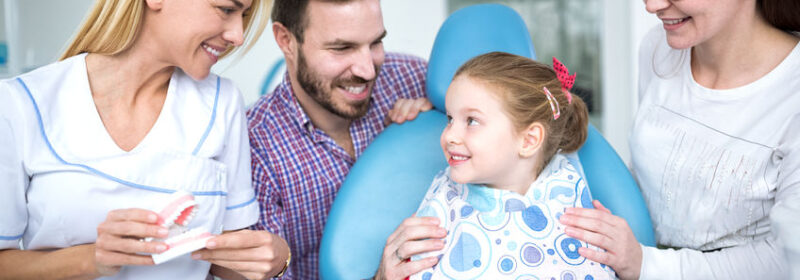
|

|

|

|

How to Get Your Toddler Used to The Dentist’s Office
The dentist’s office with its formidable chair with scary equipment attached to it can put off even a brave soldier. It is no surprise that little children are wary of going into the office and sitting in the big chair. It is a nerve wrecking experience for most people when they first visit the dentist. The little ones may get unnerved if you take them to the dentist after they have learnt the meaning of the equipment and how they work. The early you start the better result you will get. Before your child understands the connotations of the chair, and the drill machine and so on, it is best to introduce him to all these in an informal friendly way which will not let the fear set in.
The first visit to the dentist
It is important that the dentist comes across as a friendly person, who is there to help. Plan your first dental visit when your child is in a happy mood and fresh, not tired with a lot of play or sleepy after a meal. The best time to plan a first visit would be after he has had his breakfast feeding of milk and fruit. This way he will have rested and energetic. You can start with sitting in a normal chair beside the dentist’s chair, and introduce the dentist as someone who will help us all with our teeth. Then the dentist may want to talk to the child and offer simple toys to keep him busy and interested. Then you can sit on the chair with toddler in your lap so that he feels secure. There may be very simple checking of the mouth in this visit.
In the next visit the dentist may slowly introduce his equipment and tools that they use routinely, which should put the child at ease with all that equipment. This can be achieved only when the dentist’s approach is friendly showing that he does not mean any harm to the child. If your dentist shows respect to the child, he will build trust. For any kind of work in the future, it is important that the child trusts the dentist completely. A trusting relationship with the dentist will go a long way towards good work with the child.
Once you visit the dentist, you may want to get a make-believe set for role play for the child where you become the dentist and the child is there to see you. If possible, the siblings can take part in the play and you may be able to say things about teeth and cleanliness during play. Pretend play is an excellent way to teach basic concepts about the dentist and the dentist’s chair whereby you can fend off some of the fears of the child and make him confident for the next visit to the dentist. During the play and even during the real visit it would help if you avoid using negative language or refer to anything that may have fearful connotations. Hurting, paining, or fearful are the words that should be avoided at all costs.
Use positive language like health, smile, help and cleanliness which will reassure the child and will give a positive bent to the visit to the dentist.
The play may include heroes like dentists and he is there to make you free of bad guys in your mouth.
Now, the waiting area of the dentists’ offices are fun places, where small games are kept to keep the children occupied with interesting things they can do. Being comfortable before the meeting is helpful while in the office with the dentist.
Parents should not show fear
Another important factor in alleviating the dental fears is for the parents to be fearless themselves. As is well known, the children learn everything from parents, at least initially in the first few years of the child’s life. If as a parent you are afraid of the dental visit, you are sure to pass on the fear to your child. Children tend to copy the parents in everything including their emotional and physical responses to situations. If you show your worry before the visit to the dentist, the child is learning to fear the dentist himself without ever knowing the reason. Even if you are worried about the dentist visit, avoid showing it to your child. Do not discuss your worry about the dental visit with your partner in front of the child. In fact, try to build a healthy concept about the dentist yourself which will be passed on to your child naturally. Leading by example is anytime easier than giving explanations. Getting your child ready for the dentist’s appointment will be easier if you follow a few simple guidelines including:
Start early
As discussed above, it is best to start with the dental visits before the child has cut his first tooth. Before 6 months. This will lessen the anxiety associated with the dental work in the dentist’s chair. Growing up with the concept of the dentist’s office will make it feel part of life.
Start with happy visit of the dentists’ clinic. Familiarity with the atmosphere in the dental clinic will make the child more compliant with the dental visits.
Use positive language, and avoid negative words. Using positive words help children associate the dentist’s office with positive feelings. Sometimes unknowingly, parents talk of the dental visits in words like it will not hurt, or it will not be painful giving a hint to children that hurt or pain is possible. When you do not make a fuss when your child falls while taking his first steps, or fails while climbing on the jungle gym, the child has leanrt to take these in his strides and move ahead. Similarly, do not go out of your way to make the child feel secure and avoid anxiety by talking all the time about the visit. Just introduce the dentist and make the whole experience naturally happy and child will have learnt his lesson. He will behave in a natural way to the visit as he has learnt to enjoy his new experiences of the world and will learn to take the dental as a part of everyday life.
Pretend play helps building a realistic concept of dental care and oral hygiene.
Food before the visit to the dentist. It is recommended to feed the child before the visit so that child is comfortable. Choose light foods and avoid fizzy drinks or heavy meals as it may make the child hyper active or sleepy.
Explain while waiting for your turn in the dentist’s office. When the child knows what to expect, they feel secure and are ready to do what is asked. Do not push or pull or show haste while entering the room because it may make the child unsettled. Be calm yourself, and the child will follow.
Comfortable clothes help moving in the dentist’s chair.
Be with the child all the time to make him feel secure.






